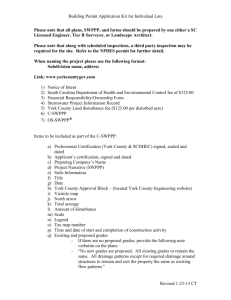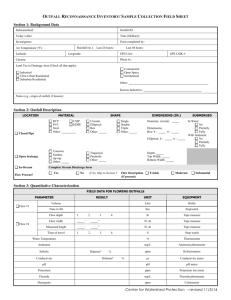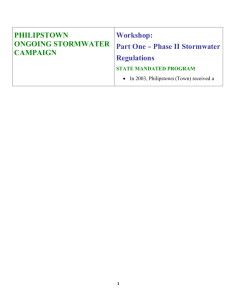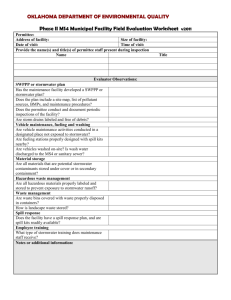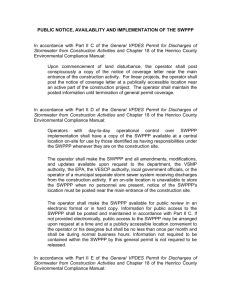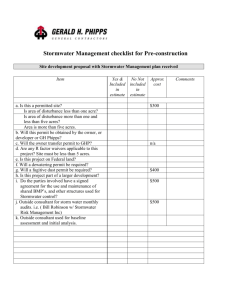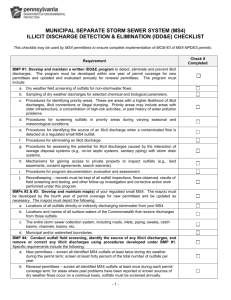2014 version - word - Arkansas Department of Environmental Quality
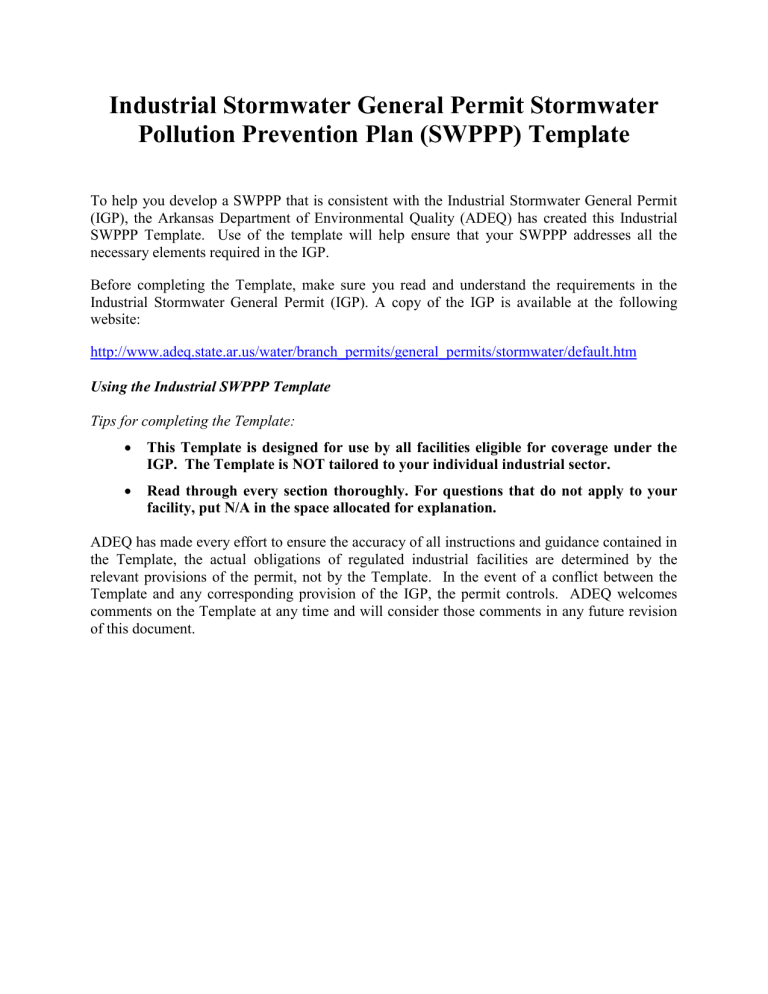
Industrial Stormwater General Permit Stormwater
Pollution Prevention Plan (SWPPP) Template
To help you develop a SWPPP that is consistent with the Industrial Stormwater General Permit
(IGP), the Arkansas Department of Environmental Quality (ADEQ) has created this Industrial
SWPPP Template. Use of the template will help ensure that your SWPPP addresses all the necessary elements required in the IGP.
Before completing the Template, make sure you read and understand the requirements in the
Industrial Stormwater General Permit (IGP). A copy of the IGP is available at the following website: http://www.adeq.state.ar.us/water/branch_permits/general_permits/stormwater/default.htm
Using the Industrial SWPPP Template
Tips for completing the Template:
This Template is designed for use by all facilities eligible for coverage under the
IGP. The Template is NOT tailored to your individual industrial sector.
Read through every section thoroughly. For questions that do not apply to your facility, put N/A in the space allocated for explanation.
ADEQ has made every effort to ensure the accuracy of all instructions and guidance contained in the Template, the actual obligations of regulated industrial facilities are determined by the relevant provisions of the permit, not by the Template. In the event of a conflict between the
Template and any corresponding provision of the IGP, the permit controls. ADEQ welcomes comments on the Template at any time and will consider those comments in any future revision of this document.
Stormwater Pollution Prevention Plan (SWPPP)
For
Industrial Activity
National Pollution Discharge Elimination System
General Permit # ARR000000
Permit Tracking Number:
A RR00
Prepared for:
Insert Facility Name
Insert Facility Address
Insert City, State, Zip Code
Insert Facility Telephone Number (if applicable)
Industrial Sector -
SIC -
NAICS -
Prepared by:
SWPPP Preparation Date:
1.
SWPPP Team (see Part 4.2.2 of the permit)
List the person(s) or position(s) responsible for developing the SWPPP and assisting the facility or plant manager in its implementation, maintenance, and revision. Clearly identify the responsibilities of each team member.
Please note that common positions (i.e. secretary, operator, etc.) may not be used. A specific position or individual’s name must be listed.
Name Title Individual SWPPP Responsibilities
2.
Employee Training (see Part 3.1.8 of the permit)
A record of employee training will be kept in Appendix A. Below are the two types of employee training required for a facility:
Storm Water Pollution Prevention Team training, and
Facility worker training specific to the area they work.
In the table below, designate the frequency of training for each training type (at least annually).
Training Type
Frequency of
Training
Topics Covered in Training
SWPP Team training
Work area specific training
Monitoring, inspection, planning, reporting, documentation requirements, and BMP maintenance
BMPs and control measures used in specific work area
3.
Facility Description
For this section, describe everything pertaining to the stormwater drainage area covered by each outfall at your facility.
A.
Outfall Information
Outfall Number:
Outfall Coordinates:
Latitude: ° ’ ” N
Longitude: ° ’ ” W
Receiving
Streams
Outfall Number:
Outfall Coordinates:
Latitude: ° ’ ” N
Longitude: ° ’ ” W
Receiving
Streams
Copy and paste the table above for each additional outfall at your facility.
If your facility is located in an MS4, provide the MS4 name below:
MS4 name:
(put N/A if your facility is not located in an MS4)
B.
Industrial Activities
In the table below, describe the industrial activities that take place at the facility, list the pollutants associated with each activity, and list the outfalls affected by the activity. This list must include all significant materials that have been handled, treated, stored, or disposed, and that have been exposed to stormwater in the three years prior to the date the SWPPP is prepared or amended.
Industrial Activity
Associated
Pollutants
Outfall(s)
Affected
C.
Exposed Inventories
In the table below, describe any tanks, bins, or piles within the outfall coverage area, list the pollutants associated with each storage entity, and list the outfalls affected by the activity.
Include any inventory containing salt for deicing and any tank or storage container susceptible to spilling or leaking.
Inventory
Associated
Pollutants
Outfall(s)
Affected
D.
Non-Stormwater Discharges (see Part 4.2.4.4 of the permit)
In the table below, describe any authorized non-stormwater discharges, the pollutants associated with that discharge, and the outfalls affected by the discharge. See Part 1.6 of the permit for a list of authorized non-stormwater discharges. Include illicit non-stormwater discharge testing information in Appendix B.
Non-Stormwater Discharge
Associated
Pollutants
Outfall(s)
Affected
E.
Impaired Stream Designation (see Part 4.2.7 of the permit)
In the table below, list any streams or other waterbodies downstream of the facility’s discharge that are impaired and list their impairments. Consult the documents at the links below to determine if any of your receiving streams are impaired.
303 (d) and Total Maximum Daily Load (TMDL) (Stream classification starts on page 8): http://www.adeq.state.ar.us/water/branch_planning/pdfs/303d_list_2008.pdf
Extraordinary Resource Water (ERW), Natural and Scenic Waterway (NSW), or
Ecologically Sensitive Waterbody (ESW) (Stream classification starts on page 52): http://www.adeq.state.ar.us/regs/files/reg02_final_140324.pdf
Impaired Waterbody name Cause of Impairment pH
F.
Monitoring Requirements
In the table below, list any parameters being monitored at the outfall. Include any benchmarks or limitations required and the frequency of sampling for each parameter (at least once per year). The sampling data, including any will be kept in Appendix C.
Parameter
Check
Box if a
Limitation
Benchmark or
Limitation
Frequency of
Monitoring
☐ 6.0-9.0 S.U.
Total Suspended Solids (TSS) ☐ 100 mg/L
☐
Describe the procedures for gathering storm event data, as specified in Part 3.8.2.
Responsible Staff:
Logistics:
Laboratory to be used:
G.
Best Management Practices
In the table below, list the best management practices implemented and the back-up measures used if the BMP is being worked on. For industry-specific expected pollutants and recommended BMPs, please see the EPA’s website at: http://cfpub.epa.gov/npdes/stormwater/swsectors.cfm
Records of BMP maintenance and inspection will be kept in Appendix D.
Best Management Practice Back-Up Measure
H.
Facility Site Map
Include a site map in Appendix G that adheres to the requirements set forth in Part 4.2.3 of the permit. You will find the same list of requirements in Appendix G.
I.
Inspection Schedule and Procedure
In the table below, list the person(s) or position(s) responsible for inspecting, the schedule for conducting inspections, and the specific items (BMPs, outfalls, storage units, etc.) to be covered by the inspection for the two types of inspections listed below:
Routine facility inspections (see Part 5.1.1 of the permit); and
Comprehensive site inspections (see Part 5.1.2 of the permit).
Inspection records will be kept in Appendix E.
Inspection Type
Person(s)/Position(s)
Responsible
Inspection
Frequency
Items Inspected
Routine facility
Comprehensive
4.
Similar Outfall Designation (see Part 3.8.1 of the permit)
Based on the information provided for each of the outfalls at the facility, list in the table below any outfalls considered to be similar, the reason why their discharges are expected to be similar, and the outfall at which monitoring will take place.
Similar Outfalls Reasons for Similar Discharges
Outfall to be
Monitored
5.
Spill and Leak Response Plan (see Part 3.1.4 of the permit)
Describe the procedures for preventing and responding to spills and leaks in Appendix F. List below the person(s) or position(s) responsible for contacting help during a spill or leak emergency as well as the Agency to contact, and the Agency phone number. A record of any spills and leaks, including any within three years of the effective date of this permit, will be kept in Appendix F.
Person(s)/Position(s) Responsible for Contacting Emergency
Response Agency
Agency Name
Agency Phone
Number
6.
Housekeeping Practices (see Part 3.1.2 of the permit)
Waste material will be picked up every days.
Routine inspections for leaks and conditions of drums, tanks, and containers will be conducted every days.
Additional Information (if necessary):
7.
Certification (see Part 7.9 of the permit)
The certification must be signed in accordance with the provisions of 40 CFR 122.22, as adopted by reference in APCEC Regulation 6. See Part 7.8 of the permit for signatory requirements.
“I have read Part 4.2.7.3 of the permit pertaining to the attainment of water quality standards after authorization and agree to adhere to its requirements.”
“I certify under penalty of law that this document and all attachments were prepared under my direction or supervision in accordance with a system designed to assure that qualified personnel properly gathered and evaluated the information submitted. Based on my inquiry of the person or persons who manage the system, or those persons directly responsible for gathering the information, the information submitted is, to the best of my knowledge and belief, true, accurate, and complete. I am aware that there are significant penalties for submitting false information, including the possibility of fine and imprisonment for knowing violations.”
Title: Name:
Signature: Date:
APPENDIX A
Employee Training Schedule:
Person(s) or Position(s) Trained
Date of
Training
Description of Training
APPENDIX B
Non-Stormwater Discharges:
Part 4.2.4.4 of the permit requires identification and elimination of all illicit discharges. This section also requires that the SWPPP contain a certification that the discharge has been tested or evaluated for the presence of non-stormwater discharges and all identified unauthorized discharges have been eliminated.
Potential significant sources of non-stormwater discharges:
Description of the results of any test or evaluation for the presence of non-stormwater discharges:
Evaluation criteria and testing method used:
Date(s) of testing or evaluation:
On-site drainage points that were directly observed during a test:
If evaluation is not possible, describe why:
“I certify that the discharge has been tested or evaluated for the presence of illicit nonstormwater discharges and that all identified unauthorized discharges have been eliminated”
“I certify under penalty of law that this document and all attachments were prepared under my direction or supervision in accordance with a system designed to assure that qualified personnel properly gather and evaluate the information submitted. Based on my inquiry of the person or persons who manage the system, or those persons directly responsible for gathering the information, the information submitted is, to the best of my knowledge and belief, true, accurate, and complete. I am aware that there are significant penalties for submitting false information, including the possibility of fine and imprisonment for knowing violations.”
Print Name Title
Signature Date
APPENDIX C
Sampling Data:
Include all Stormwater Annual Reports (SWAR) as attachments to this appendix. The SWAR must be attached no later than the 31 st
day of January of the year following the sampling (ie,
January 31 st 2015 for year 2014) and must be provided within five business days of a request by the Department.
A copy of the SWAR can be found at the following link: http://www.adeq.state.ar.us/water/branch_permits/general_permits/stormwater/default.htm
Date of Sample Rainfall (inches) Outfall(s) Sampled
Date of Last Storm
Event
APPENDIX D
BMP Maintenance Records:
BMP
Date Issue
Found
Date of
Maintenance
Description of Maintenance
APPENDIX E
Inspection Records:
Keep the completed inspection forms as an attachment to this appendix.
Type of
Inspection
Date of
Inspection
Outfalls
Inspected
Significant Findings
APPENDIX F
Spill Prevention and Response Procedures (See Part 3.1.4):
Include the procedures for preventing and responding to spills and leaks. The procedures may reference the existence of other plans for Spill Prevention Control and Countermeasure (SPCC) developed for the facility under Section 311 of the CWA or BMP programs otherwise required by an NPDES permit for the facility, provided that a copy of that other plan is kept onsite and made available for review consistent with Part 5.3
Input procedure here:
Spills and Leaks Records:
Description of Spill or Leak
Date Spill or Leak
Occurred
Outfall(s) Affected by Spill or Leak
APPENDIX G
Site Map:
The site map must address the following at minimum. Attach a copy of the site map in this appendix.
1.
the size of the property in acres;
2.
the location and extent of significant structures and impervious surfaces;
3.
directions of stormwater flow (use arrows);
4.
locations of all existing structural control measures;
5.
locations of all receiving waters in the immediate vicinity of the facility,
6.
locations of all stormwater conveyances including ditches, pipes, and swales;
7.
locations of potential pollutant sources;
8.
locations of all stormwater monitoring points;
9.
locations of stormwater inlets and outfalls, with a unique identification code for each outfall, indicating if one or more outfalls is being treated as “substantially identical” , and an approximate outline of the areas draining to each outfall;
10.
municipal separate storm sewer systems (MS4), where the stormwater discharges to them (if applicable);
11.
locations and descriptions of all non-stormwater discharges identified;
12.
locations of the following activities where such activities are exposed to precipitation: fueling stations; vehicle and equipment maintenance or cleaning areas; loading/unloading areas; locations used for the treatment, storage, or disposal of wastes; liquid storage tanks; processing and storage areas; immediate access roads and rail lines used or traveled by carriers of raw materials, manufactured products, waste material, or by-products used or created by the facility; transfer areas for substances in bulk; machinery; and salt storage piles; and
13.
locations and sources of run-on to the site from adjacent property that contains significant quantities of pollutants.
